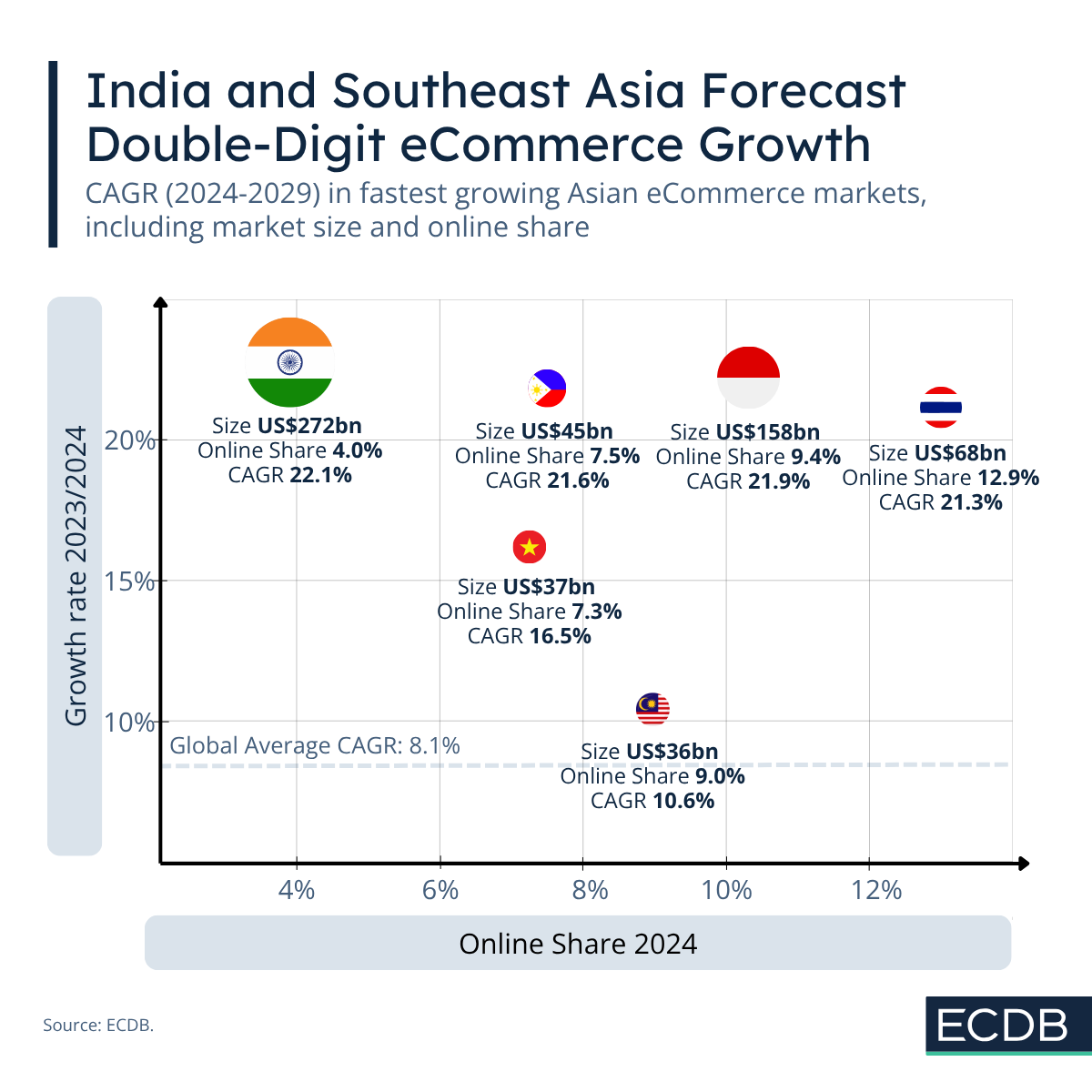Shein and Temu’s Hypergrowth Era Is Over – 2026 Brings a Harsh Reality Check
After years of record-breaking expansion, the fast-fashion giants face their toughest year yet.
eCommerce Growth Markets
India and Southeast Asia exceed the global average CAGR (2024-2029) of 8.1% significantly. Here is why.

Nadine Koutsou-Wehling
Data Journalist
August 04, 2025
Market Trends

The Asian continent has the highest potential for global eCommerce, with many markets exceeding the world average CAGR (2024-2029) of 8.1%. Apart from the smaller, well-established markets, Asia has a remarkable number of countries with growth trajectories worth discussing.
Market size does of course contribute to higher growth, as smaller markets are more likely to grow faster because less revenue is needed to achieve significant percentage increases. Apart from that statistical reality, however, there are many more factors to consider.
For the analysis, we picked a threshold above US$10 billion in annual market revenue to ensure a minimum level of relevance. The top markets with a CAGR (2024-2029) of at least 10% reveal a group of highly thriving eCommerce regions.
At the top ranges of expected CAGR (2024-2029) development are India (22.1%), Indonesia (21.9%), the Philippines (21.6%) and Thailand (21.3%). These countries exceed the world average of 8.1% and vary in size and reasons for growth.
Following a little further behind but still significantly ahead of the world average are Vietnam (CAGR of 16.5%) and Malaysia (10.6%). As two smaller markets with a low online share, they do not belong to the top tier of high-potential markets, yet they are still noteworthy.
Five of the six fastest-growing eCommerce markets in Asia are in the Southeast Asian region. Southeast Asia (SEA) is of remarkable significance to eCommerce development. This is also evident in the dominant platforms in the respective online markets, which overlap.
Two aspects stand out in that regard: China’s influence is undeniable, as large part of the top eCommerce players in SEA are operated by Chinese companies. They include Lazada (powered by Alibaba), TikTok Shop (operated by ByteDance), Taobao and Tmall (two platforms by Alibaba).
Contrasting this is Shopee, an eCommerce platform headquartered in Singapore, although its shares are internationally distributed. Shopee ranks as the largest marketplace in all of the SEA markets, and its influence is growing. Shopee is usually followed by Lazada, its closest competitor owned by Alibaba.
The online shares of these markets are mostly between 7.0% and 10.0%, with Thailand the only exception of a relatively high share of 12.9%. Its positioning at the right-end side of the illustration highlights Thailand as a market to look out for in the coming years of eCommerce development.
India is simultaneously the market with the highest CAGR and the only one outside of Southeast Asia depicted as a growth market. Its status as the most populous country, with a young, tech-savvy consumer base, and a still-low online share, makes India attractive to eCommerce companies looking to expand.
Two of the leading U.S. players already control 83% of the top 10 marketplace’s revenues. Apart from that, India has a variety of domestic companies that play an important role in the market, backed by government policy.
Overall, however, the market is expected to see annual revenue increases of around 17% in a few years, with a current rate of 20.4%. Additionally, India's proximity to eCommerce leader China makes it attractive to foreign investors looking for alternatives to China's growing dominance in Asian eCommerce.
Related Articles
After years of record-breaking expansion, the fast-fashion giants face their toughest year yet.
TikTok Shop is now the third-largest eCommerce retailer in U.S. Care Products. It is still far behind the two market leaders, but has surpassed other retailers with less competitive strategies.
Cleaning Equipment, Pharmaceuticals and Meal Kits convince where High Heels & Pumps, Curtains & Blinds, Medical Products and Cameras fail.

Click here for
more relevant insights from
our partner Mastercard.
Our Tool
We’re not just another blog—we’re an advanced eCommerce data analytics tool. The insights you find here are powered by real data from our platform, providing you with a fact-based perspective on market trends, store performance, industry developments, and more.
Analyze retailers in depth with our extensive Retailer dashboards and compare up to four retailers of your choice.
Learn More
Combine countries and categories of your choice and analyze markets in depth with our advanced market dashboards.
Learn More
Compile detailed rankings by category and country and fine-tune them with our advanced filter options.
Learn More
Discover relevant leads and contacts in your chosen markets, build lists, and download them effortlessly with a single click.
Learn More
Benchmark transactional and conversion funnel KPIs against market standards and gain insight into the key metrics of your relevant market.
Learn More
Our reports provide pre-analysed data and highlight key insights to help you quickly identify key trends.
Learn More
Find your perfect solution and let ECDB empower your eCommerce success.